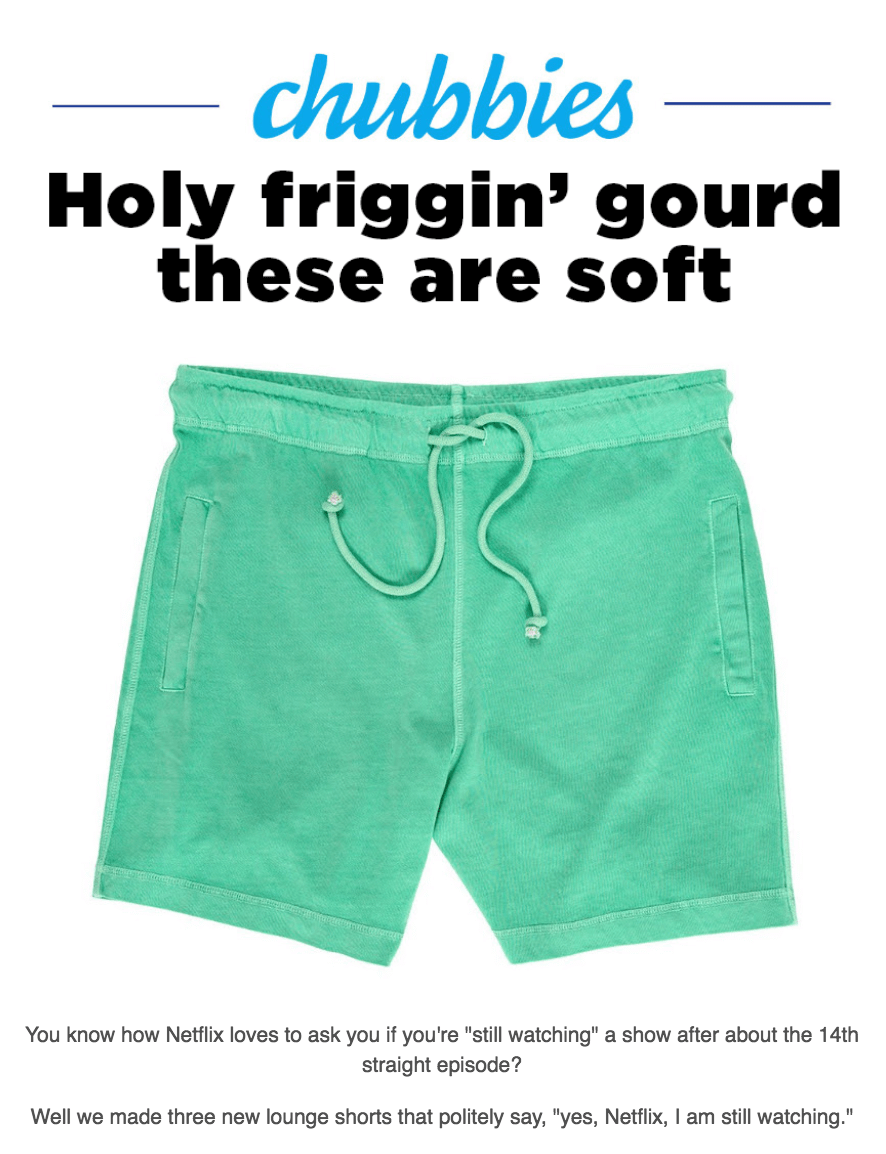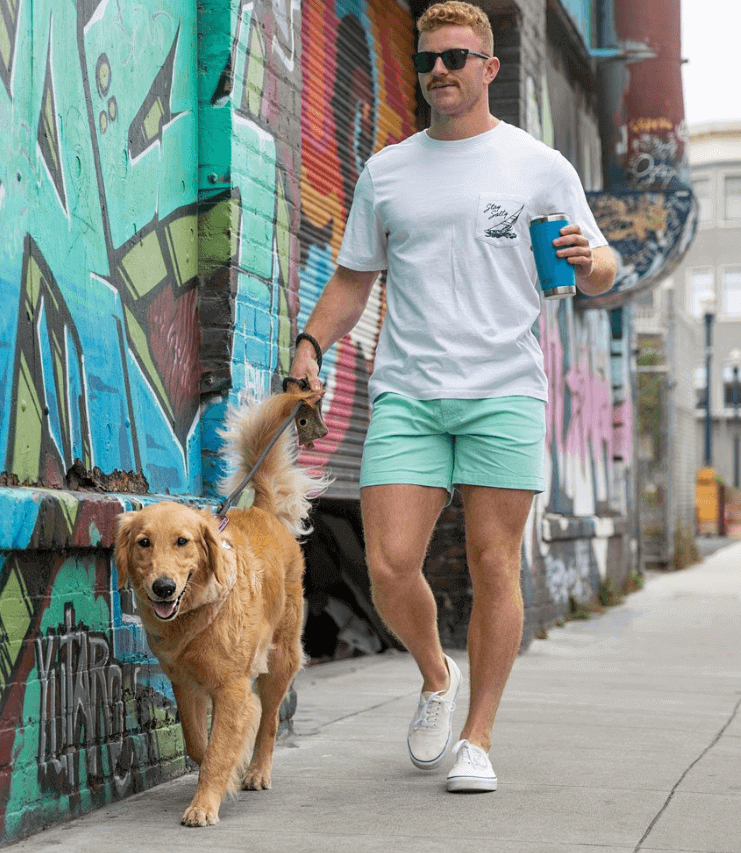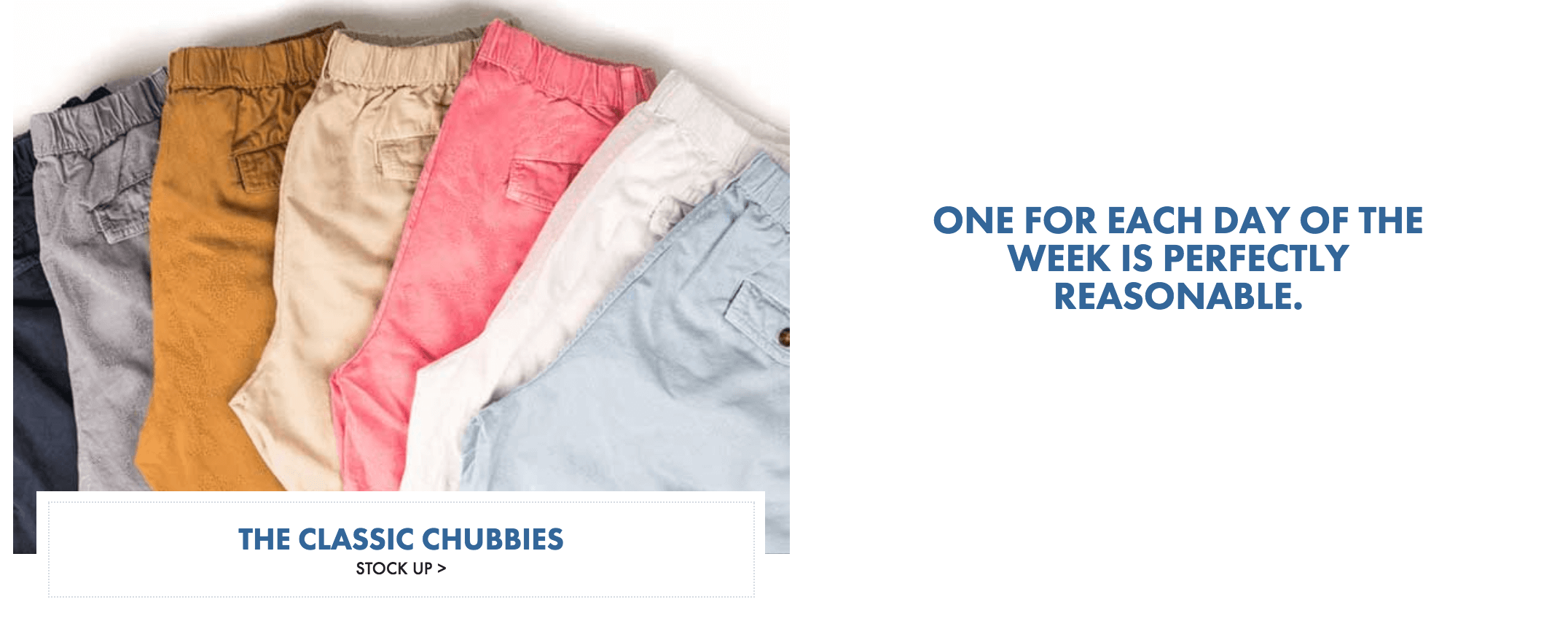Chubbies exploded onto the direct-to-consumer scene nearly seven years ago with a line of short-shorts for men in playful colors and patterns.
They’ve since expanded their offering to include bathing suits, sportswear, and women’s swimwear, while growing a fiercely loyal community of ambassadors and fans.
In this recording from eTail West 2018, Chubbies Co-founder Rainer Castillo speaks with Yotpo CEO Tomer Tagrin about what goes into building and growing a dedicated customer community.
For highlights from the video, check out the edited transcript below.
Treating your customers like your friends
Rainer: Yeah. So from day one, when we first made those shorts for our friends, the way we told our friends about it was, my co-founder wrote a really funny email. And he said, “This weekend, we’re all going to wear these shorts. I’m going to show up with them. If you want a pair, you’re going to owe me 50 bucks.” If you’ve ever gotten Chubbies’ email, it was exactly the tone of that email that we send out — that’s what he sent to our friends.
And I think a realization for us from day one was that it’s really important to treat your customers like your friends. I think that was really natural for us because our customers were our friends out of the get-go. You know, that went to all reaches of our company and it was a mantra that we all have been attached to for a long time, we still talk about it today. We have a cultural tenet, which is “customers greater than company, greater than self.” And a lot of what we do is bring the customer to the forefront.
I think when you read an email from us, the tone of that email, the way it’s written, it’s as if Tom had written that email to a friend. And I think it still is consistent today, it is very much that style.

Another example of this for us is when we get emails from customers. I think a lot of people will send them out to customer service or somebody else will handle it. It’s just so important for us. We got an email from a customer who said that his car had been broken into, and all of his Chubbies had been stolen, and we replaced all of his Chubbies that he had lost, and we got him karate lessons to make sure it didn’t happen again.
And so, there’s stuff like that or it’s like, you’re just listening to a customer and understanding sort of their situation and being really responsive when you can empathize with the sort of the situation they’re in. It’s been really, really useful for us.
Understanding what your customer wants
Rainer: I was fortunate enough to work in retail prior to starting the company. So, I spent time with the Gap, spent time with Levi’s. A lot of people who’ve started these digitally native brands are really afraid of embracing some of the best practices of retail. I’ve seen some quotes that I think people regret about physical retail or about approaching things that are some of the best practices.
And I think one of those things that I learned in my background was that being good at selling products to people requires you to first and foremost understand your customer. And for me, that was selling men’s underwear at GAP, and then, selling Dockers pants at Levi’s. I had to learn who that customer was and figure out how to develop something for them. The same thing applies to this. And I think people shouldn’t be afraid of embracing the best parts of traditional retail.
I think one of those things is a derivative of the idea of an old school focus group. For us, when we have a conversation with our customer, it’s fluid, and it’s real, and it’s asking questions and understanding what they want and don’t want.
Rainer: Everybody in my company has so many feedback loops — just the number of times where somebody in the corner of our office will run up and say, “I just heard this.” I think we all believe that one vocal minority is somebody who probably has a bigger problem in the base of your customers or a bigger thing to be excited about. And so I think we’re really reactive when we do those things. We’re constantly building feedback loops from your software, which is fantastic, and we read what happens there.
My leadership team also has monthly calls. We have these leadership calls with five customers a month. And we’ll say, “Alright. This month, the focus is customers who haven’t purchased in eight months or who bought this type of product and then never bought it again, or customers who bought 100 pairs of shorts.” Whatever the customer group may be, we focus on having one-on-one conversations with them, bringing that back to our team, and distributing those learnings pretty broadly.
I think other things for us — it seems really formulaic — but post-purchase surveys. Somebody who goes through the effort of putting their thoughts in an email and sending it to you — if you’re not spending time reading that, reacting to that, responding to them — this is somebody who cares enough to say something, right? And so that streams straight to our Slack. Whenever we see feedback that says something positive or negative, we’re immediately reacting to it, looking at it, and saying, “What can we do differently?”

Some examples that have come up — there are some obvious ones: Things like fit, it’s really, really great to get feedback rapidly from customers. Or feedback from customers who’ve been with us for a long time who have seen something change: like we made a change in our loyalty programs and we stopped sending these random gifts and packages. And we heard time after time after time that there are customers who were looking for that.
We heard from guys who were over 6’5’’. They said, “You know what? I’m really loving the brand, but a 5.5 inch short on someone who’s 6’5’’ is not just a short short. It’s a really short short.” And we started to get some feedback that there was a need for something a little longer. We came out with a 7-inch short.
Those are all things that you get through having these fluid conversations. Your response to those notes back to you are things that build so much trust and loyalty in what you’re doing. At the end of the day, it’s a business. But the reason we’re doing this is to make it the best for the customer, and I think that that comes through in all the interactions that my team has with people.
The behind-the-scenes of fostering brand loyalty
Rainer: I think first and foremost it’s the core belief. I mean, we have that cultural tenet, customers greater than company, greater than self. We have a culture committee on our team, which is a group of six people across the company that rotates every few months, and their focus is on making sure that the customers’ voice is in every conversation. So, there’s stuff you can do like that that is just in our DNA.
I think there are true data points to show that if I give a loyalty gift to this customer, I actually see the relativity change over time. They are more willing to come back and spend with us. So, I think those things are there. Those things are there and I think you have to be really responsive to that.
When you’re willing to listen to a single voice, sometimes it’s hard to see a statistical significance in something. And so, for me, a lot of this is intuition-based and a lot of it is driving to what feels best for the customer, and so we’re not always going to have a hard result on that stuff.
Rainer: I think for us, we’ve been really thoughtful about trying to programmatize loyalty in the community as much as possible. And so the feedback we got that was like, “Excuse me, you no longer give me those free items.” We had for a long time, and we do again now, a pretty formal program of like, “Look, on the first purchase, I’m having this type of surprise on the line. Now, on the second purchase, I’m having this. If I bought this combination of products, I’m getting this with that purchase. And so, there’s a lot of that embedded systematically into the type of purchasing behavior we see.
We also have a number of events driven around the loyalists and biggest advocates in our community. So one is our biannual “iber” campaigns, we call them. So we have a Thighber Monday campaign, which happens to be on Cyber Monday if you’ve ever heard of that. And that was our first event, like how do we perform on Cyber Monday.
For 12 hours of the day, every purchase got a gift with it, and these were pretty sweet gifts. This year, we worked with Igloo Coolers and designed a really cool cooler that came with your purchase if your purchased a short. We designed great graphic tees. It’s a bunch of different items. That was so successful that we instituted a second one around 4th of July called 4th of Julyber Monday (obvious name), and that has been really effective.

I think another programmatized loyalty thing for us has been our ambassador program. When we first started the company, I personally wrote emails to leaders on college campuses, whether it was sports team captains or presidents of different student groups and just said, “Guys, we started this company, here’s what we do. I’m looking for the most vocal, greatest person in your group to be a representative of our brand on campus.”
And this was when we probably had three people working with us, and it was just me searching through email lists online to find these emails, and the response was overwhelming. The guys who responded said, “Actually, I have somebody for you and that person is me.” And I was like, “Okay, there’s something about this.”
We had this like great influx of people who were interested in representing the brand. We put them through some filters to make sure they were good representations. And then that program became a really core piece of our business. We would have active conversations with them in Facebook groups, which involved two different types of groups digitally that we would use. We would invite them to vote for next products that we were maybe coming out with. We’d have photo challenges with them where they would ultimately provide the fodder that became our Instagram posts and our different campaigns that we would develop. It was never a sales mechanism, it was always part of community.
And I think you’ll see that with a lot of the content we create, that we’re really not trying to be particularly sales-y on a lot of our Instagram posts or in a lot of our outbound communications. It is ideally content from the community, for the community that is, on its own, really enjoyable. And I think that that became something that has been really valuable for us over time.
How to go from click to brick the right way
Rainer: Yes. So, for us, we have eight stores, tomorrow we’re opening the ninth or Friday we’re opening ninth actually, so we’ll have nine stores really soon. All but two of those have been opened over the past 12 months. And so we’ve added big push over the past 12 months to open them because we saw a really great response from the community.
For us, these were really organic extensions of the existing customer base. The beauty of having a digital brand is you have a lot of information about where your customer is. We knew, for example, in Houston, that this was one of our top four or top five markets. We emailed every customer in that market and said, “Guys, we’re thinking of putting a store in Houston. What do you think?” That email alone for us, and this is tens of thousands of emails, we had like 30%, 40% open rates on that, for an email that’s asking about where [the store is] going to go. It was wild for us.
And we were just like, okay, these are people who participated in the survey and got through the survey and said, “You know what, here’s my favorite bar, here’s my favorite restaurant, here’s where I shop.” We were able to hone in within a neighborhood, almost to the street-level where our guy would be and where we should build that store, and it was awesome.
We came in a few months before the complex opened in Houston, and we were in the middle of a construction zone with the only building open and we had 250 people lined up outside around the corner.
It was unreal to see this and to see that when you can be that focused with an effort, such as physical retail, you have an opportunity to actually elevate their experience. So we’re doing a lot more in-store events where we say, “Hey, here’s a product we’re not offering online.” or “Here’s a new idea we have, come in and give us feedback on it.”

Each of our stores has a Tiki bar in it. And so when you go through one of stores, you’re welcome to grab a beer and hangout at the Tiki bar. We have guys who show up all the time and just come and hangout.
And what’s incredible for us is that every person we hire in those stores is very understanding of this desire to be welcoming. They all kind of preach the same mantra of customers greater than company, greater than self, and that’s something that we see as really great at building that community for those locations.
Rainer: Yeah. I think the operational complexity of moving inventory. We’re not a showroom in those stores, we’re actually putting inventory into those stores. We have our first few seasons of actually buying inventory for those stores. And the operational complexity of distributing across channels and knowing how to manage what’s best for our customer once we run out of something in one of those channels has been highly complex. And it’s something that by no means do we have years of history doing, so we’re learning on the fly.
There is an element of disappointment for customers if they see an email that comes out that says, “brand new stretch tall shorts” that came out last week. And they’re like, “I want those in-store right now.” And we’re like, “Look, the second those arrive, we put them up on the site and they’re en-route to the store but you can’t get them today.”
We have stuff to figure out there about making sure that the interaction is seamless. But I think so long as the mentality and the approach to it is consistent, we’re able to deliver to something to people that is still really enjoyable and are really responsive when it fails for them.
Community-building 101
Rainer: I think, and I just heard somebody in the other room talk about this a little bit as well, is like it’s not so much about like, “I have this community, now, I can.…” It starts with talking with a customer. And I am sure there are people out there as passionate about certain types of dog food as there are about people who love shorter shorts.
You have to find that really focused advocate group of people who love that piece of your brand and then focus and make sure that you’re responsive to it — how do you build more of the things that they love?
It was wild, somebody this morning was showing some lines saying that 0.08% of the customer base is making up 20% of the revenue. I think that exists in every brand and in every pocket that there is somebody batting way above their weight class in terms of their penetration to the brand.
And I think we see that in some segments, with the ambassador group and with other groups. It’s really about finding that niche and making sure you’re responsive to the stuff that makes them love the brand.
To learn more about how Chubbies grew into a direct-to-consumer leader, check out this video.



